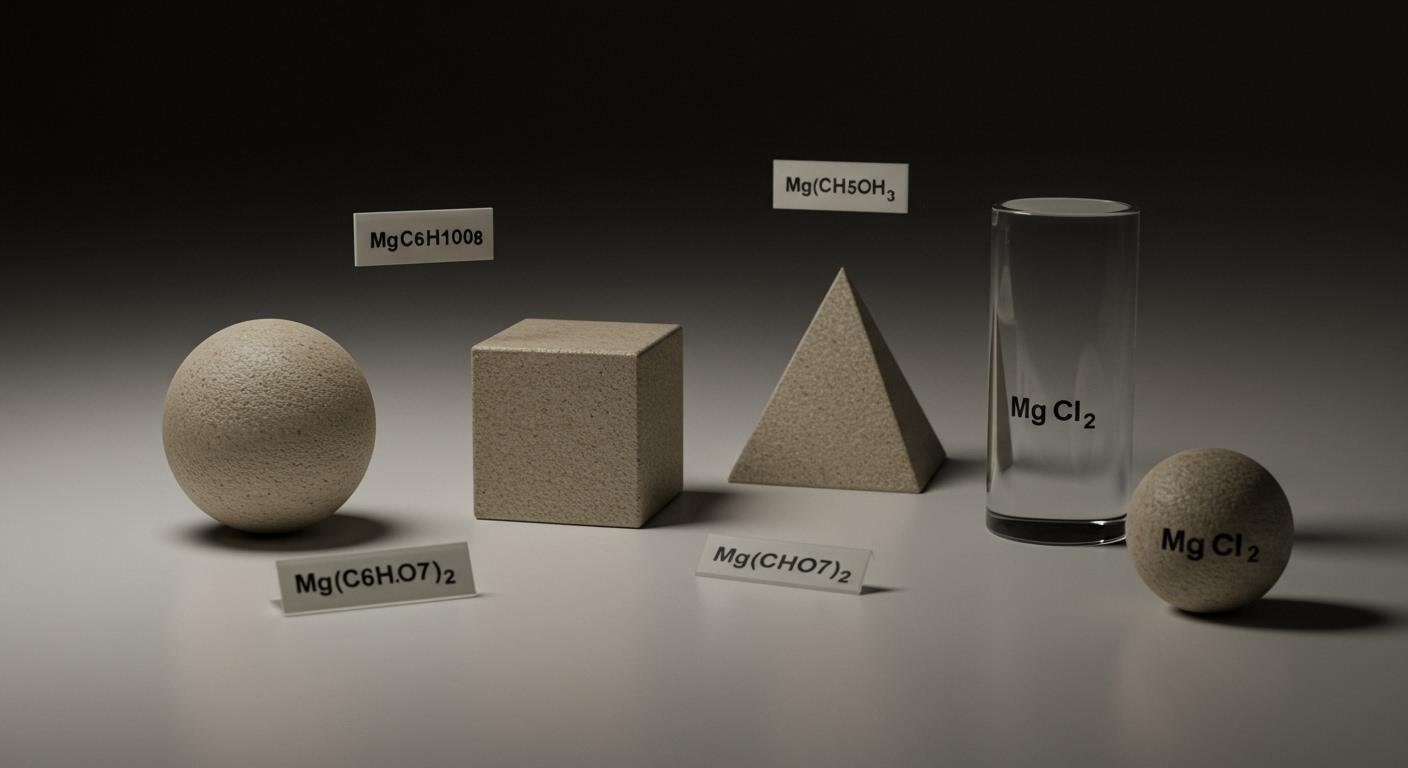What Are the Different Magnesium Forms?
Table of Contents

Common types of magnesium include magnesium glycinate, magnesium citrate, magnesium malate, and magnesium oxide. These different forms of magnesium offer unique benefits. Each magnesium supplement has a different absorption rate in the body. The market for magnesium supplements is large, valued at USD 1.5 billion in 2024, showing how many people use magnesium. This simple guide explains the main magnesium forms to help a person pick the right magnesium for their health needs. Understanding these types of magnesium is the first step toward better wellness.
A Guide to Common Magnesium Forms

Choosing a supplement can feel confusing with so many magnesium forms available. Each type offers different benefits. Understanding these different forms of magnesium helps a person select the best option for their specific health goals. This guide explores the most common types of magnesium.
Magnesium Glycinate
Magnesium glycinate is a popular choice for people seeking calm and relaxation. This form binds magnesium to glycine, an amino acid with calming properties. It is known for being gentle on the stomach.
This form is also highly bioavailable. The body absorbs it very efficiently. This high absorption makes it an excellent choice for correcting a magnesium deficiency. Studies show it is absorbed much better than other forms, like magnesium oxide.
| Magnesium Form | Fractional Absorption Rate |
|---|---|
| Magnesium Glycinate | 18.8% |
| Magnesium Oxide | 4% |
Best for Sleep and Calm 😴 Magnesium glycinate is a top pick for improving sleep and reducing anxiety.
- It is readily absorbed by the body.
- It has recognized calming effects.
- Research shows it helps relax the mind and body.
- This relaxation can reduce stress, a common cause of poor sleep.
Magnesium Citrate
Magnesium citrate is magnesium combined with citric acid. This form is well-absorbed and often used to address digestive issues. Its main function is to provide constipation relief.
It works as an osmotic laxative. The magnesium ions attract and hold water inside the intestines. This influx of water softens stool and makes it easier to pass. The process also stimulates the rhythmic muscle contractions that move contents through the digestive tract. While effective, a person should know that magnesium citrate can sometimes cause loose stools or diarrhea.
Magnesium Malate
The body’s cells use a process called the Krebs Cycle to create energy. Malic acid is a vital component of this cycle.
- An enzyme converts a molecule into malate (ionized malic acid).
- This step happens right before the creation of another energy-related molecule.
- This process leads directly to energy use by the mitochondria, the powerhouses of the cells.
Magnesium Oxide
Magnesium oxide is one of the most common forms found in stores. It is often the most affordable option. This form is a simple salt of magnesium and oxygen.
It has a very high percentage of elemental magnesium. For example, a supplement may contain 61% elemental magnesium.
| Supplement | Elemental magnesium content |
|---|---|
| Magnesium oxide | 61% elemental magnesium |
However, a major drawback is its poor absorption. The body struggles to use the magnesium from magnesium oxide. A 2019 study confirmed it had the lowest bioavailability among 15 tested supplements. Its absorption rate is estimated to be around 4%, which is very low. Due to its poor absorption, it is not ideal for correcting a magnesium deficiency but is sometimes used as an antacid for heartburn relief.
Magnesium L-Threonate
Magnesium L-Threonate is a newer, unique form of magnesium. Scientists at MIT developed it. Its standout feature is its ability to cross the blood-brain barrier more effectively than other magnesium forms. This quality makes it a promising choice for supporting brain health and cognitive function.
Research shows it can significantly elevate magnesium concentrations in the brain. One animal study found it raised magnesium levels in cerebrospinal fluid by 7% to 15%. Other magnesium compounds did not achieve this. A human study on a formula containing magnesium L-threonate showed significant improvements in memory and overall cognitive scores in healthy adults after 30 days.
Magnesium Sulfate
Magnesium sulfate is widely known as Epsom salt. People often add it to baths to soothe sore muscles and promote relaxation. In clinical settings, healthcare professionals use it intravenously for several serious conditions.
Medical Uses of IV Magnesium Sulfate 🏥
- Preventing seizures in eclampsia
- Correcting severe magnesium deficiency
- Managing acute asthma attacks
- Protecting the brain in certain situations
The idea of absorbing magnesium through the skin from an Epsom salt bath is popular. One unpublished study suggested that bathing in Epsom salts raised magnesium levels in the blood and urine. However, the study lacked a control group and proper scientific review, so more research is needed to confirm if the skin can absorb a significant amount of magnesium this way.
Choosing Your Magnesium Supplement

Selecting the right magnesium supplement depends on a person’s specific health goals. Different magnesium forms have unique properties that make them better suited for certain needs. This guide helps connect individual wellness objectives to the most effective types of magnesium.
For Sleep and Calm
For individuals seeking better sleep and a sense of calm, magnesium glycinate is an excellent choice. This form is highly absorbed and gentle on the digestive system. Its benefits come from the combination of magnesium and the amino acid glycine.
Magnesium promotes relaxation by regulating neurotransmitters in the brain. According to Dr. Austerman, magnesium helps control the release of glutamate, an excitatory chemical, while supporting the release of GABA, an inhibitory one. This action allows magnesium to mimic the effects of some anxiety medications. It interacts with GABA receptors, which reduces excitability in the nervous system and helps lower stress. The regulation of these key neurotransmitters is crucial for emotional stability and provides significant magnesium benefits.
Quick Guide: Sleep & Calm 🧘
- Goal: Improve sleep quality and reduce anxiety.
- Choose: Magnesium Glycinate.
- Why: It is highly bioavailable and has a calming effect on the nervous system without causing digestive upset.
For Constipation and Regularity
A person experiencing constipation may find relief with magnesium citrate. This form is well-known for its laxative effect. It works by drawing water into the intestines, which softens stool and makes it easier to pass.
When using magnesium citrate for constipation, it is important to follow dosage instructions carefully. Many manufacturers suggest a dose between 150–300 ml. For adults, a typical one-time oral dose is around 240 ml. A person should always read the product’s label for specific instructions or consult a healthcare provider. Taking too much can lead to diarrhea or an upset stomach.
For Energy and Muscle Function
Magnesium malate is the preferred option for boosting energy and supporting muscle health. This form combines magnesium with malic acid, a compound essential for cellular energy production. The body’s primary energy source, ATP, must bind to a magnesium ion to become biologically active. Research shows magnesium directs the chemistry that creates ATP, positioning molecules perfectly to speed up the reaction.
This form also offers great health benefits of magnesium for physically active people. A systematic review found that magnesium supplements can reduce muscle soreness and protect against muscle damage.
| Study Author(s) | Magnesium Type | Dosage | Duration | Key Finding |
|---|---|---|---|---|
| Reno A.M. et al. (2022) | Glycinate | 350 mg | 10 days | Reduced muscle soreness and improved recovery perception. |
| Cordova A. et al. (2019) | Pure | 400 mg | 3 weeks | Showed a protective effect on muscle damage. |
One study with volleyball players showed that 350 mg of magnesium daily reduced lactate production and improved performance. This evidence suggests magnesium malate is a strong choice for athletes or anyone looking to fight fatigue.
For Brain Health and Cognition
For those focused on cognitive function, Magnesium L-Threonate is a standout among magnesium forms. Its unique ability to cross the blood-brain barrier allows it to raise magnesium levels in the brain more effectively than other magnesium supplements.
Research shows that optimal brain magnesium is vital for synaptic plasticity, which is the brain’s ability to learn and form memories. Animal studies demonstrate that magnesium protects cognitive functions. It can reverse impairments in learning, memory, and the physical structure of brain cells. Magnesium is crucial for central nervous system functions because it helps manage how neurons connect and communicate. While a clinical trial was started to test Magnesium L-Threonate’s effect on memory in people with dementia, no results have been published yet. Still, its foundational role in brain health makes it a promising magnesium supplement for cognitive support.
How to Use Magnesium Safely
Using magnesium safely is important for getting its benefits without risks. A person should understand dosage, side effects, and when to talk to a doctor. This essential mineral is helpful, but proper use is key.
Daily Dosage Guidelines
| Age | Male (mg) | Female (mg) |
|---|---|---|
| 1–3 years | 80 | 80 |
| 4–8 years | 130 | 130 |
| 9–13 years | 240 | 240 |
| 14–18 years | 410 | 360 |
| 19–30 years | 400 | 310 |
| 31–50 years | 420 | 320 |
| 51+ years | 420 | 320 |
For dietary supplements, the US Institute of Medicine established a Tolerable Upper Intake Level (UL) of 350 mg per day for adults. This limit applies only to magnesium from supplements, not from food. Taking more can lead to unwanted effects.
Potential Side Effects
High doses from magnesium supplements can cause problems. The most common side effects of magnesium are related to digestion.
- Diarrhea
- Nausea
- Stomach cramps
Certain forms, like magnesium oxide and magnesium citrate, are more likely to cause these issues. While these are used to correct low magnesium levels, taking too much magnesium can disrupt the digestive system. Very high intake can lead to more serious symptoms like muscle weakness or low blood pressure.
Food Sources vs. Supplements
Food is the best source of magnesium. Many foods naturally contain this mineral, helping people meet their daily needs and avoid a magnesium deficiency. Dietary supplements can help fill nutritional gaps for those with low magnesium levels.
Top Food Sources of Magnesium 🥑
- Pumpkin Seeds: 156 mg per ounce
- Chia Seeds: 111 mg per ounce
- Almonds: 80 mg per ounce
- Spinach: 78 mg per half-cup
- Dark Chocolate: 65 mg per ounce

Consulting a Healthcare Professional
A person should always talk to a doctor before starting magnesium supplementation. This is especially important for people with medical conditions like kidney disease or those taking other medications. A doctor can check for a true magnesium deficiency and help a person with low magnesium levels choose the right magnesium supplement.
Warning: Seek Medical Help Immediately 🚨 Magnesium toxicity is rare but serious. A person experiencing symptoms like severe vomiting, breathing difficulties, muscle weakness, or irregular heartbeat needs immediate medical attention.
Choosing the right magnesium depends entirely on a person’s individual health needs. The different magnesium forms offer unique benefits. For instance, some magnesium promotes relaxation, while other magnesium supports digestive regularity. A person should always seek professional advice before starting any new magnesium supplement.
Important Note 🧑⚕️ A doctor can help a person determine if they need more magnesium and select the best option for their specific situation.
FAQ
When is the best time to take magnesium?
The best time to take magnesium depends on the form. A person can take calming magnesium, like glycinate, before bed. Other magnesium types are fine anytime. Taking any magnesium supplement with food helps prevent stomach upset and improves how the body uses the magnesium.
Can a person take different forms of magnesium together?
Yes, a person can combine different magnesium forms. Many supplements are a magnesium complex. This provides the benefits of each magnesium type. A person must track their total magnesium intake. The total daily magnesium from supplements should stay within safe limits for magnesium.
What are the signs of low magnesium?
Early signs of low magnesium include muscle cramps, fatigue, and weakness. A person might also feel nauseous. A long-term lack of this essential magnesium can cause more serious issues. A doctor can test a person’s magnesium levels to confirm a deficiency in magnesium.
How long does it take for magnesium to work?
The effects of magnesium vary. A person may feel the laxative effect of a specific magnesium form within hours. For sleep or mood, it can take several weeks of consistent magnesium use to notice changes. The body needs time to restore its magnesium levels.
Does every person need a magnesium supplement?
Not everyone needs a magnesium supplement. A balanced diet often provides enough magnesium. People with certain health conditions or diets might need more magnesium. A healthcare provider can determine if a person needs a magnesium supplement to boost their magnesium intake. This ensures proper magnesium levels.

Poseidon
Master of Nutritional Epidemiology, University of Copenhagen, Herbal Functional Nutrition Researcher
Focus: The scientific application of natural active ingredients such as Tongo Ali, Horny Goat Weed, and Maca to sexual health and metabolic regulation.
Core Focus:
Men: Use a combination of Tongo Ali (an energizing factor) + Maca (an energy reserve) to improve low energy and fluctuating libido.
Women: Use a combination of Horny Goat Weed (a gentle regulator) + Maca (a nutritional synergist) to alleviate low libido and hormonal imbalances.
Stressed/Middle-Aged Adults: This triple-ingredient synergy supports metabolism, physical strength, and intimacy.
Product Concept:
Based on traditional applications and modern research (e.g., Tongo Ali promotes testosterone-enhancing enzyme activity, and icariin provides gentle regulation), we preserve core active ingredients and eschew conceptual packaging—using natural ingredients to address specific needs.
Simply put: I'm a nutritionist who understands "herbal actives." I use scientifically proven ingredients like Tongo Ali, Epimedium, and Maca to help you make "sexual health" and "nutritional support" a daily routine.
